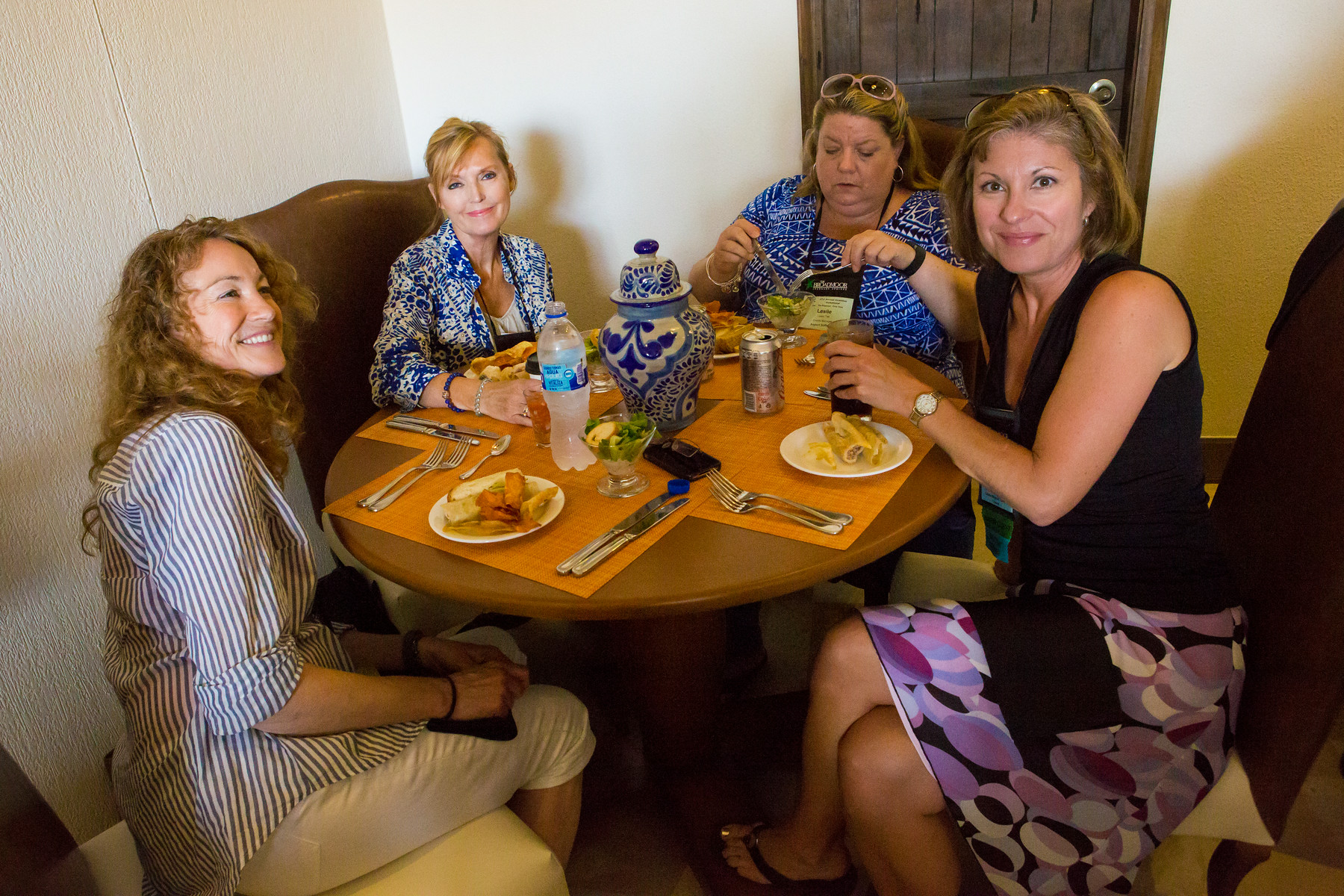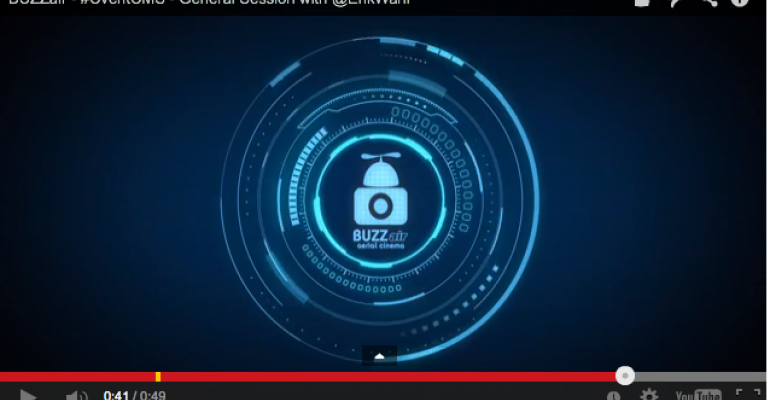Yes, I have been a-traveling lately, and I've done some incredibly cool stuff (swimming with dolphins! Ziplining! Learning about Cvent's new Blue Release and the Incentive Research Foundation's latest data!). But more to the point, I've experienced some incredibly great ideas you may want to consider adapting, or at least dreaming about, for your next meeting or event.
1. Drones! OK, author/artist/all-around awesome idea man Erik Wahl was a stellar keynote speaker at Cvent's Corporate and Association Meetings Summits (the summits shared general sessions and activities, but had separate breakout tracks, all held at the Venetian in Las Vegas), but when a BUZZair drone from redbutton.tv starts buzzing overhead filming the whole thing, to the tune of Bastille's Pompeii as the paint flies across the oversized canvas, well, check it out for yourself:
Or, for a much more professional drone's-eye view of the conference, here's the Cvent cut (note the drone's selfie at the end—too cute):
As redbutton's Sam Stanton is quoted as saying in our latest MeetingsNet app issue, "It's amazing how a little altitude can change the whole perspective and production value." Oh yeah.
2. Geocaching. Before I leave the topic of the fabulous Erik Wahl (can you tell I was very impressed with him? Even though not long before leaving for the Summits I was telling someone who had never seen an artist keynoter that I was kind of over the concept, then along came Erik to take it up a few hundred notches.), he did a couple of things that actually injected some creativity into a ballroom full of 1,000 people. One involved the dreaded pulling someone out of the crowd and onto the stage, but the way he did it was brilliant (I don't want to spoil it for anyone who hasn't seen him yet), and she got a pretty great reward for being a good sport. But the coolest thing he did was offer a treasure hunt of a sort: He planned to hide one of the paintings he did at the session somewhere in Las Vegas and leave geocache clues via Twitter starting at 11:59 that evening. I had one of those "get up at 3 a.m. and fly all day and through three time zones" days and couldn't get my body to agree to stay up that late, but boy did I want to!
3. Tailor your game to your event's theme. That's what the Incentive Research Foundation did at its recent Invitational in Los Cabos, Mexico, thanks to a very cool app by QuickMobile. Because the education centered around how companies—and incentive programs—can benefit from research on positive psychology, the happiness-themed app game included 10 ways to earn points toward some pretty nifty gifties that would make anyone happy. While some were for things like completing evaluataions, scheduling activities, sending tweets to the event's hashtag, and downloading documents, you also could check in with sponsors and IRF trustees via the unique QR codes on their badges (which makes them happy), tag photos of places that make you happy at the Secrets Puerto Los Cabos, the event's host (too many to count!), send someone a positive message, and submit daily messages of gratitude/acts of kindness/most fun moments.

. IRF also turned the lunch on its education day into brainstorming sessions designed to completely redesign the incentives field. Attendees were pre-sorted into groups via stickers on their name badges, which they matched with signs held by designated leaders at the end of the morning sessions. These folks then led the groups to various locations throughout the Secrets property for lunch and brainstorming on the question, "If we were starting the incentive industry from scratch, what would we do?" I can't speak for the other groups, but I know mine was really engaged in the conversation throughout the lunch, and winnowing down all the thoughts we had recorded was tough. But in the end, after everyone reconvened and our group leaders presented our ideas for a vote, my group's entry actually won the contest for best idea. But I would have liked the way they turned a meal into a way to meet new people and work together toward a common goal anyway, I swear.

. You know how, if your event is at a resort property, everyone would rather hang out at the pool than linger inside to chat with the experts you so conveniently have lined up for them? Instead of fighting that inclination, IRF joined it. The education day presenters had a designated area in one of the property's pools and a designated time to be there to participate in what IRF called "Pool Ponderings, Deeper Dives with the Experts." I meant to participate, but either got back too late from the afternoon's adventure or otherwise got preoccupied elsewhere. I heard from someone who did that it was an excellent way to get some one-on-one time with subject matter experts in their field.
6. Display attendees' social posts and pics. One of Cvent's latest product releases, SocialWall, was on display at the Association and Corporate Meetings Summits, and it was in fact a great way to see what people were saying on Twitter and posting on Instagram about the meetings. I went to a demo, and it was cool to see how it can be customized with different display animations, colors, themes, and backgrounds. And comforting to know that event organizers can filter the posts and moderate the content (I hear there was an very inappropriate post made to the event's hashtag—this was, after all, in Las Vegas) that was caught and deleted in time. You also can use a widget to embed the feeds on your event Web site, so those who aren't able to join can easily follow along.
7. Connecting people using a "face book." It kind of made my head spin a bit, but a few days after returning home on a red-eye from Vegas I was off to the gorgeous campus of The Taft School in Connecticut for the edACCESS conference, an annual gathering of information technology staff at secondary schools and small colleges. There was so much at this conference—a participant-driven event facilitated by Adrian Segar, who literally wrote the book on peer conferences—that it's hard to choose just one thing to highlight here (there will be a full-blown article as soon as I can get to it).
So maybe I'll just start with the beginning—the best conference t-shirt ever. The slogan? "I'm not crazy. And I'm not alone." Love that! I'm not educational techie, but don't we all feel that way sometimes?
OK, more seriously, here was one thing edACCESS did that I'd love every conference to start with. The 50 or so participants sat in one big circle (Adrian says this does scale, just break your larger group into groups of 50 or so) and were given two minutes exactly—there was a timer—to give their answers to three questions: How did I get here? What would I like to have happen? What experience or expertise do I have that others may find useful? The facilitators also passed out a "face book" that listed each participant, with photo, school, title, contact info, and areas of expertise, among other things.
The woman I sat next to was taking a bunch of notes on the profiles in her face book about who had expertise at what. Most of what they talked about was incomprehensible to me, but she was planning to get together with those folks who could help with the specific technology challenges she had. Participants also were told to raise their hand if they hear someone who needs help on an issue they have expertise in. So right up front you got to know a little about each person, let people know exactly what information you'd be seeking during the four-day conference, and find those who could help you and those you can help. It was awesome. And it just got better from there.
What have you seen/done/experienced lately at a meeting that you'd like to see more of? Leave a comment below or e-mail me.




